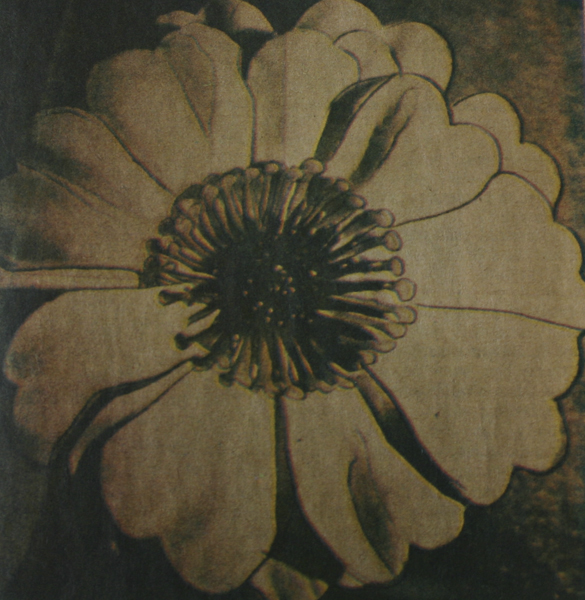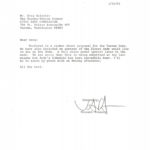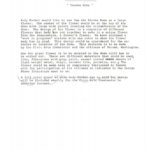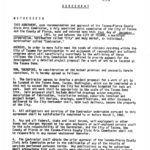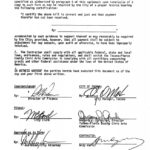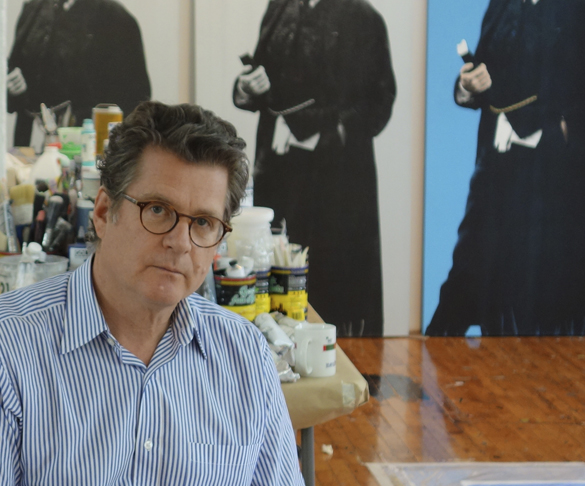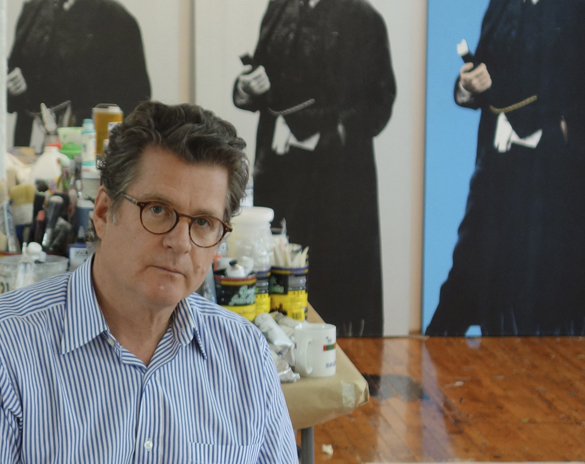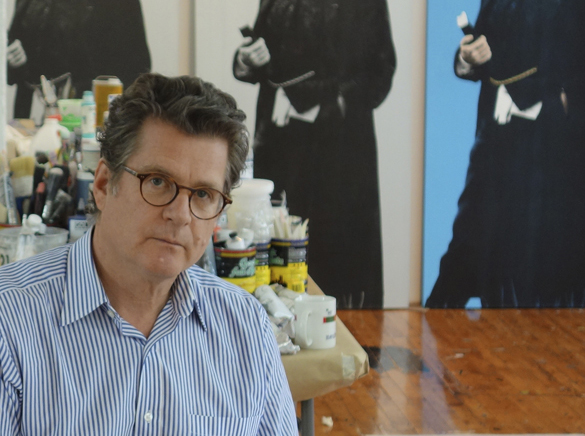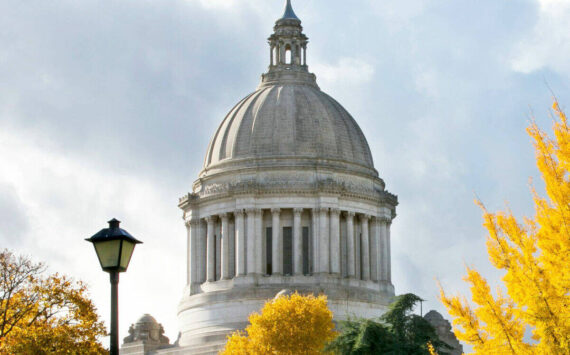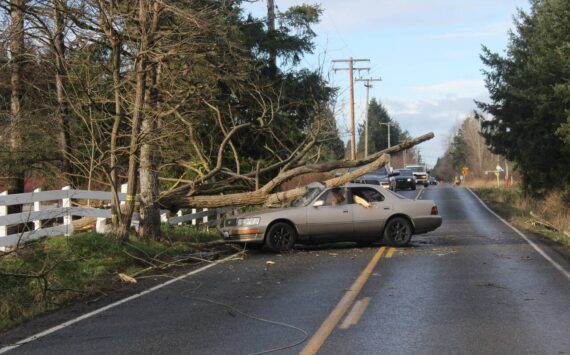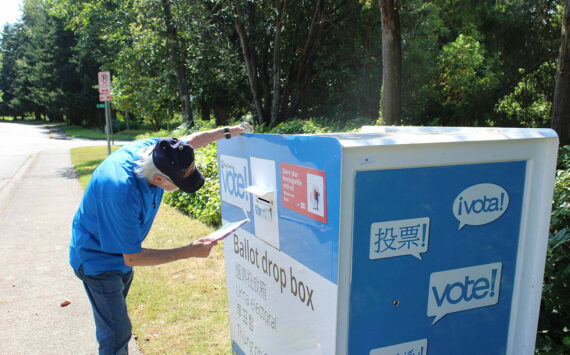Thirty-three years ago, Vincent Fremont was managing Pop artist Andy Warhol’s New York City studio when a commission landed on his desk and intrigued both Fremont and his boss.
The City of Tacoma was building a $28 million indoor arena, and $280,000 was set aside for public art. While the building was under construction, the City convened a panel of art experts to attract high-profile, blue-chip artists to submit art proposals. Warhol was one of several artists asked to create original art for the Tacoma Dome.
Whether it was the dollar amount ($4,500 to submit a proposal; $280,000 if the proposal was selected) or the scale involved (Warhol envisioned the Dome’s 260,000-square-foot roof as a giant canvas for his art) that piqued Warhol’s interest is still unclear today, but the artist created an original design for Tacoma and directed Fremont to submit the work.
On Jan. 26, 1982, Fremont wrote a simple, two-page proposal to officials at Tacoma City Hall. “Andy Warhol would like to see the Tacoma Dome as a large flower,” he wrote. “The center of the flower would be at the top of the Dome with large wide petals covering the circumference of the Dome. The design of the flower is a composite of different flowers that Andy has put together to make it a unique flower from the imagination, a flower’s flower.”
The letter included an acetate version of the flower, as well as questions about how to install the art. “How the giant flower is to be mounted on the Dome still has to be worked out,” wrote Fremont. “There are different materials that could be used, like fiberglass with epoxy paint, enamel coated sheets of lightweight material, vinyl, ceramic tile, porcelain, et cetera. The flower could be made here or completely fabricated in Tacoma with the participation of its citizens as indicated in the design phase literature sent to us.”
In the end, four artists—Stephen Antonakos, Richard Haas, George Segal, and Warhol—created art for the Dome. Antonakos envisioned a roof painted blue and illuminated by neon arcs and angles. Haas imagined a cluster of stars and constellations. Segal’s proposal, destined for the inside of the Dome, included statues of trapeze artists and acrobats. In the end, Antonakos’s neon design was briefly selected before it was de-selected after much public hand-wringing, as well as concerns the art might compromise the roof’s structural integrity. Instead, Antonakos created neon art for inside the Tacoma Dome—a move that led to more rounds of controversy and public outcry.
More than 30 years later, the mood has changed and public art at the Tacoma Dome is in the news again. A campaign is under way to place Warhol’s design atop the Dome. In February, Tacoma City Council voted unanimously to support a campaign to raise money for the project. The estimated $5.1 million needed to see Warhol’s work crown the City-owned downtown arena will come from the private sector—not City coffers.
I recently asked Fremont—who is 64 years old and lives in New York City—if Warhol had even heard of Tacoma when the public art commission arrived at Warhol’s studio. “I think so,” Fremont replied amusedly. “We weren’t living under a rock in New York City. I certainly was aware, originally being from California.” Fremont noted that Warhol was in Seattle in late 1976 for the Modern Art Pavilion exhibition at Seattle Center, for which he created original work. “It puts Andy in Washington State, and he certainly would have been aware of Tacoma,” he added. “I don’t think he came to Tacoma, but he did travel.”
It’s hard to know exactly why a world-famous artist briefly turned his attention toward Tacoma, but it’s tempting to think he had some fondness for this Pacific Northwest city. By most counts, Warhol agreed to create only one other public art commission—a mural depicting the mug shots of 13 criminals, it was created for the 1964 World’s Fair in New York but was painted over following its own round of controversy. Warhol also created an entire series entitled ‘Flower for Tacoma Dome’ based on the Tacoma commission.
“Andy was known for multiple or repetitive imagery,” Fremont told me. “But in the case of the Tacoma Dome project, he liked the idea of a single flower image for maximum impact.”
Fremont was born in San Diego, California, and arrived in New York City more than 40 years ago with a group of friends who were Warhol admirers. “We looked like a rock and roll band, but we didn’t play any instruments,” Fremont told me during a telephone interview from his New York City office. Fremont started working for Warhol on a freelance basis before he was hired full-time. He spent the next 16 years as one of Warhol’s closest associates right up until the artist’s death at age 58 in 1987.
Fremont went on to serve as a founding director of the Andy Warhol Foundation for the Visual Arts. He was also a committee member that created the Andy Warhol Museum in Pittsburgh, Pennsylvania. In recent years, Fremont has produced films and served as an art advisor and artist representative.
I contacted Fremont to include him in the Tacoma Daily Index‘s ongoing series of profiles and oral histories that feature key people associated with the history of public art at the Tacoma Dome. The series began in March with the local architect Lyn Messenger, who created the original rooftop design for the Dome (see “Tacoma Dome: Before Warhol’s flower, Lyn Messenger drew diamonds on the Dome,” Tacoma Daily Index, March 30, 2015), and continued last month with Ellida Lathrop, who pushed for the One Percent for Art ordinance that eventually created a budget for public art at the Dome (see “Tacoma Dome: How Ellida Lathrop helped to shape public art at the Dome,” Tacoma Daily Index, April 6, 2015), and Amy McBride, the City of Tacoma’s Arts Administrator who is currently advocating for Warhol’s work atop the Dome (see “Tacoma Dome: For Amy McBride, Warhol’s rooftop flower is larger than the Dome,” Tacoma Daily Index, April 14, 2015).
The series continues today with Fremont. Our conversation has been edited for clarity and abridged for publication.


“I started by opening up the studio every morning, sweeping the floors, answering phones.”
I arrived in New York City in August of 1969, the weekend of the Woodstock Festival. I met Andy Warhol within the first three days of being in the city. I did some freelance writing for Andy during the fall of 1969, but returned to Los Angeles in January of 1970 to deal with my Draft Board. I returned to New York City in December of 1970 and reconnected with Andy, Paul Morrissey, and Fred Hughes—Andy’s exclusive business manager and close friend. Andy asked me to work full time at his studio in January of 1971.
I started by opening up the studio every morning, sweeping the floors, answering phones, et cetera. I was made vice-president of Andy Warhol Enterprises, Inc. in 1974 and became executive studio manager. I collaborated on video projects with Andy beginning in 1973 and ended up producing all of the Andy Warhol Studio video projects and cable TV shows.
Upon Andy’s untimely death in February of 1987, Hughes, John Warhola—one of Andy’s brothers—and myself were in Andy’s will and directed to create a charitable foundation for the advancement of the visual arts.
“Andy liked to create new artwork for commercial commissions.”
I don’t know if he was approached that often to do public art. There was the public art he created for the New York World’s Fair. But he was pressured to have it destroyed and painted over because it was too controversial. I thought it looked great. There wasn’t a lot of public art like there is in today’s world. Over the last 15 years, there has been a lot of public art. It’s a lot more prevalent now. Back in the 1970s and 1980s, I do not remember many artists being involved in creating public art in New York City. Warhol did commissioned artwork—mostly portraits of well-known people—for magazines like Vanity Fair, Time, French Vogue, et cetera. He did not like licensing images of his 1960’s artwork. Andy liked to create new artwork for commercial commissions.
“Andy, this might be a good idea.”
At the time [of the Tacoma Dome commission], I was negotiating more of the corporate and commercial commissions. I handled the Absolut Vodka contract, the 501 jeans painting he did for Levi’s. There were requests for all sorts of stuff. I would have been the one to look at this particular request [for the Tacoma Dome]. I may have said, “Andy, there is this large commission. This might be a good idea.” More than likely, I was the intermediary. I may have convinced Andy to get involved. We would have talked about it. We would have had some discussions. It was a kind of interesting idea. What would have intrigued Andy about the commission was creating new art. He liked to create new art. He would normally bounce ideas off the people who were around him. He generally had a good idea of what he wanted to do. Also, I would have had to interpret, in some fashion, how to tell people on the other end what he wanted to do.
“It would have had a big impact.”
Andy had been doing flowers since the 1950s. It was a natural progression. The flower [he created for the Tacoma Dome] is a hybrid of more than one flower. It doesn’t exist in the real world. He liked to do things like that. The fact that he decided to make it one big flower was intriguing to him. He was known for multiple imagery, but because this was in the shape of the Dome, to Andy, it would have had a big impact. Still, I was a little concerned about the technology that was available at that time. It would have had to have been made out of ceramic tiles. What material would you make it out of? We weren’t specific about it at that time. There were some discussions about what materials to use. Maybe ceramic might have been too heavy. I don’t know what technology would have been available that would have been practical.
“From an aerial view, it would look beautiful.”
I heard about this [latest] idea [to put Warhol’s art on the Dome] at least two years ago. I think it would be great. Maybe the technology exists today to do it justice. From an aerial view, it would look beautiful. But the artist is no longer here. I think we sent them a finished print. That would probably be the best image to use because Andy sent that one. If Andy’s art had been picked [for the Tacoma Dome], there would have been more input from him.


****Thanks to Paul Kasmin Gallery in New York City for permission to use their photograph of Vincent Fremont and Deborah Kass. More information about Paul Kasmin Gallery is online at paulkasmingallery.com.
To read the Tacoma Daily Index‘s complete and comprehensive coverage of a proposal to place Andy Warhol’s art atop the Tacoma Dome, click on the following links:
- 4 contractors respond to RFI for Tacoma Dome roof cleaning (Tacoma Daily Index, May 12, 2015)
- Tacoma Daily Index Top Stories — April 2015 (Tacoma Daily Index, May 1, 2015)
- City explores cost to clean Tacoma Dome’s roof (Tacoma Daily Index, April 21, 2015)
- Tacoma Dome: For Amy McBride, Warhol’s rooftop flower is larger than the Dome (Tacoma Daily Index, April 14, 2015)
- Tacoma Dome: How Ellida Lathrop helped to shape public art at the Dome (Tacoma Daily Index, April 6, 2015)
- Tacoma Daily Index Top Stories — March 2015 (Tacoma Daily Index, April 1, 2015)
- Tacoma Dome: Before Warhol’s flower, Lyn Messenger drew diamonds on the Dome (Tacoma Daily Index, March 30, 2015)
- Tacoma Daily Index Top Stories — February 2015 (Tacoma Daily Index, March 2, 2015)
- City Council vote would formally support Warhol art atop Tacoma Dome (Tacoma Daily Index, Feb. 6, 2015)
- Top Stories 2014: #1 — Warhol Tacoma Dome (Tacoma Daily Index, Dec. 31, 2014)
- ***UPDATE*** City Council committee to revisit plan for Warhol art atop Tacoma Dome (Tacoma Daily Index, Dec. 1, 2014)
- A rooftop test for Tacoma Dome Warhol flower (Tacoma Daily Index, April 22, 2014)
- Discussion continues on Warhol Tacoma Dome roof plan (Tacoma Daily Index, April 17, 2014)
Todd Matthews is editor of the Tacoma Daily Index, an award-winning journalist, and author of A Reporter At Large and Wah Mee. His journalism is collected online at wahmee.com.
